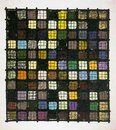Leadline 1994: Josef Albers: Works in Glass (Part Two)
 by Jason Peter Brown on June 10, 2007
by Jason Peter Brown on June 10, 2007
 Filed Under: REPRINTINGS, LEADLINE
Filed Under: REPRINTINGS, LEADLINE
This is a reprinting of part two of a five part original article on Josef Albers by Doreen Balabanoff. It originally appeared in Leadline in 1994. You can read Part One here.
Undoubtedly, Albers arrival at the Bauhaus in 1920 came at a moment in his life when he was ripe for exploration and change. Much later, he described its impact: "I was 32… threw all my old things out the window, started once more from the bottom, that was the best step I made in my life."
Having supported himself by teaching in primary and secondary schools, Albers had studied at the Art Academy in Munich (1919-20) and had, prior to that, attended the Kunstgewerbschule in Essen on a part-time basis (1916-19). This school was a manifestation of the growing interest in the manual arts that seemed to arise in response to the modern industrial state. There he had studied drawing with Jan Thorn-Prikker, a Dutch artist associated with Henri Van der Velde and the Art Nouveau movement. Thorn-Prikker had, by the turn of the century, turned almost exclusively to stained glass window design, and is known as one of the 'fathers' of modern stained glass in Germany. He was a teacher who "often met with his students at the school in his free time, and he and Albers discussed, among other things, the art of Cezanne, for whom they shared a great admiration". Albers began, at this time, to work in the medium of stained glass, producing his first commission for St. Michael's Church in Bottrop, his home town (1917-18). Not surprisingly, the design of this window has some affinities with Thorn-Prikker's work.
Well trained as a visual artist, and with a family background steeped in craftsmanship (blacksmithing, carpentry, house and set painting, stained glass etc) Albers was ready for the Bauhaus proclamation of 1919, which stated that "there is no essential difference between the artist and the craftsman" and that "the artist is an exalted craftsman".
Albers entered the Bauhaus "filled with hope and optimism… particularly anxious to do practical work, that is, handicraft, and looked forward to being allowed to enter the glass workshop at the end of the first semester". He submitted to the Vorkurs, the preliminary course run by Johannes Itten, but did not see eye to eye with Itten, who assigned him to the wall-painting course, informing the faculty council that "Albers has no colour". Albers objected, on the grounds that he had done much set-painting with his father as a youth, and refused to attend the workshop meetings. Warned by Gropius, then Director, that he would not be able to remain at the Bauhaus, Albers avoided dismissal by irregularly attending, and "spent the majority of his time in independent study, experimenting with assemblages of broken glass and other materials".
Finances, too, played into Albers move towards glass at this time. Unable to afford materials, he went to the local dump and collected shards of glass and scrap metals. "Pick axe in hand and rucksack on his back", he "learned to kill bottles", "that is, to smash bottles in such a way that the flat, usually circular bottoms of the bottles remained intact."
The works he produced, small independent stained glass panels, were Albers' first non-representational works. Though composed of random scrap materials, they were not without order and discipline. Window-like elements, grid and cross structures punctuate the compositions, and give an indication of ideas that would preoccupy Albers for years to come.
Albers decided to show these pieces at the year end student show. He later wrote:
I felt that my show would be my swan song at the Bauhaus…But soon thereafter I received a letter from the Masters Council informing me, first, that I could continue my studies…and secondly asking me to set up a new glass workshop for them…Thus suddenly I got my own glass workshop and it was not long before I started to get orders for glass windows.
Continued in Part Three
